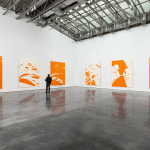
Contributed by Jonathan Stevenson / “You Don’t Have to Tell Me Twice,” Mark Bradford’s galvanizing tour de force at Hauser & Wirth, was a three-story exhibition of arresting coherence. His muscular paintings grab you by the lapels, pull you in, and visually immerse you to a point of satisfying comprehension. That’s remarkable for any paintings, rare for substantially abstract ones. The show’s first-floor keynotes were Johnny the Jaguar, which plants the Americas’ largest apex predator as a camouflaged but fierce symbol of human aggression, and the mixed-media Manifest Destiny, which strips that notion of its putative grandeur by way of distressed found materials in three overlapping panels displaying the phrase “JOHNNY BUYS HOUSES” – a mundanely rapacious mantra, he figures, for gentrification via eviction as a form subjugation descended from colonial expropriation, slavery, and Jim Crow. Bradford thus aims to spirit sanitized American history and its acutely toxic post-revisionist renditions from their pedestal and expose their false conceits.

The other paintings on the first floor, in the adjacent room, are at first glance Pollock-esque in their thoroughgoing abstractness, but in fact are stealthily referential. In the haunting Where Lee Goodwin Was Jailed and Lynched, a roiling black-and-tawny field suggests a ravaged, half-obliterated Black community, incorporating minute but unmistakable touches of red. The diptych Two-Faced presents two ostensibly similar panels, but the birds clearly discernible in the first are hard to make out in the second, jangled by a surfeit of color: some who apprehend the same landscape as others are denied the comfort of resolution. Jungle Jungle, Fire Fire, and Haint Blue likewise present figures, natural phenomena, and verbal description – animals, fire, trees, the hue preferred for slave quarters, the names of places – shakily identifiable but overwhelmed by more ontologically elusive whirls of color and line. Here the functionality of abstraction becomes manifest: it gives visual substance to internalized repression. Styled after tapestries favored by medieval European elites, this set of paintings reflects fresh protagonists asserting a heretofore silenced point of view.




Overall: 120 x 224 inches, each panel 120 x 112 inches
Bisecting the exhibition, on the second floor, was Death Drop, a 1973 Super 8-filmed scene looping in 20-second intervals of Bradford himself, age 12, falling as though stricken by a bullet in an alley, menaced by a large dog (the jaguar?) whose shadow appears on the other side of a fence. This fatalistic notion was recapitulated on the fifth floor in an identically titled outsize sculpture, made 50 years later, of his fallen body. Its iconic dance pose, however, mordantly implies that there’s still plenty of life in the artist. Surrounding it were four monochromatic paintings of monumental scale, the title canvas claiming pride of place. All reference African Americans’ historic exodus from the brutally inhospitable South. Muted grays and grid squares marked by times from train schedules connecting origins and destinations in the Great Migration supplant the histrionic color and violent line of the first-floor paintings, as if to provide a steady and objective foundation for what is likely to remain, for the foreseeable future, an embattled and perilous polemic. In at least one of the four, there is perceptible red.

In the service of a controlled passion for a mission, Bradford deftly and strategically embeds representational content in overarchingly abstract work. Without explanatory mediation, his paintings visually impart an intuitive understanding that guides and tracks with closer inspection and intellectual dissection. In that sense, he has harnessed the power of abstraction. His alacritous confrontation of a dark past is perhaps akin to Anselm Kiefer’s. But, as an African American, Bradford comes at his task as a legacy victim rather than a lineal victimizer, and his sensibility is more constrained and systematic. The ultimate feel of his work is that of vindicating quest rather than bombastic confession. If his message is now more contrived and orchestrated than it once was, that may be an understandable product of urgency.
“Mark Bradford: You Don’t Have to Tell Me Twice,” Hauser & Wirth, 542 W. 22nd Street, New York, NY. April 13, 2023–July 28, 2023.
About the author: Jonathan Stevenson is a New York-based policy analyst, writer, and editor, contributing to the New York Times, the New York Review of Books, and Politico, among other publications.























Wish This review had come sooner. Sounds and looks like a FANTASTIC show. Wish I could see it. I’d expect no less from Mark Bradford.